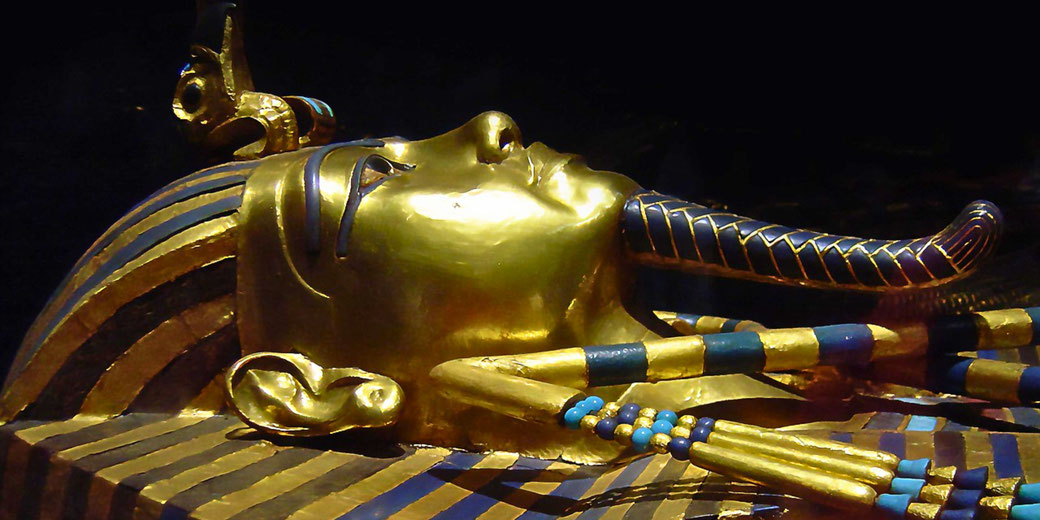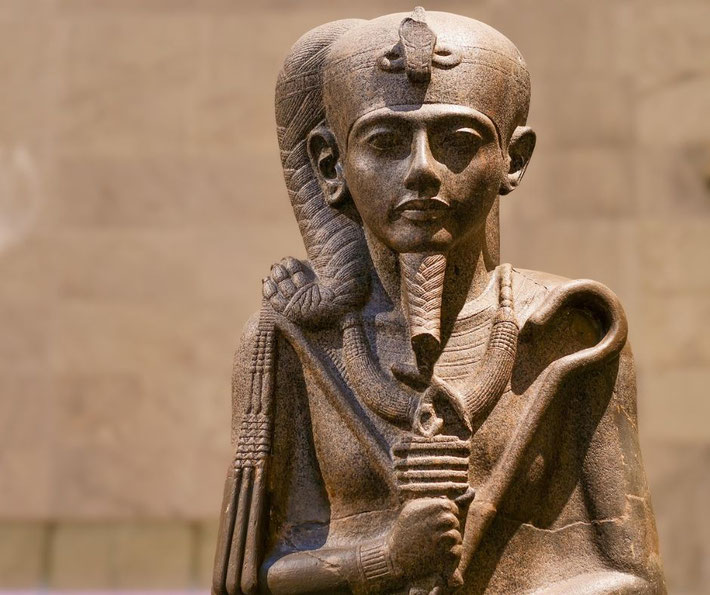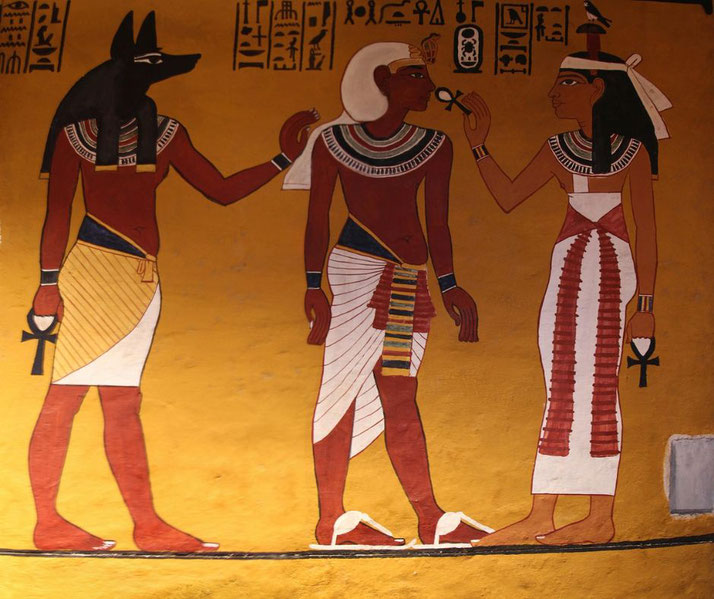The mysterious life and death of Tutankhamun

When you talk to most people about ancient Egypt, there is always one pharaoh that they can name: Tutankhamun.
Out of the countless Egyptian rulers, he is by far the most famous, which leads people to assume that he must have been the most powerful, most wealthy, or at least the pharaoh who ruled the longest. However, none of those are true.
In fact, pharaoh Tutankhamun ruled less than ten years. What is more, we have no record of any great achievements during his time in power: no great wars nor battles, no great building projects nor political achievements.
In fact, Tutankhamun's life is one of the most uneventful of all of the pharaohs.
So why do so many people know about him?
Well, Tutankhamun became famous due to events and mysteries that occurred 3000 years after his death.

What Tut's dad did
Before we delve into Tutankhamun's life, it's important to understand the religious revolution that occurred under his father, Akhenaten.
Akhenaten was a controversial pharaoh who rejected the traditional polytheistic religion of worshipping many gods.
Before Akhenaten, the Egyptians believed in hundreds, if not thousands, of gods and goddesses who they worshipped through temples and statues.
But Akhenaten decided that there should only be one god, and that god was called Aten.
Akhenaten also ordered the construction of a new capital city called Amarna, also called Akhetaten, where he built a huge temple to Aten.
As a result of this new city, the period of time when Akhenaten and Tutankhamun ruled Egypt is known as the 'Amarna Period'.
The dramatic shift in religion caused significant upheaval in the country and ultimately proved unpopular.
Therefore, after Akhenaten died, the people of Egypt were looking for a new ruler who would return the old religion and its many gods.

Tutankhamun's time as pharaoh
Tutankhamun was a pharaoh during the 18th Dynasty of ancient Egypt. He was born somewhere around 1341 BC in the ancient Egyptian capital city of Akhetaten.
Originally, Akhenaten had called him Tutankh-aten, to honour his new god, Aten.
Following the death of Akhenaten in around 1332 BC, Tutankh-aten became pharaoh.
However, he was quite young when he took the throne: probably around 9 or 10 years old. He is often called the 'boy king' by people today.
As he took charge of the country, the young pharaoh abandoned his father's religious revolution and returned to the old Egyptian religion.
By his third year as pharaoh, the Egyptian people were allowed to worship the old gods again. He even moved the capital city from Akhetaten to Memphis.
Also, around this time, he changed his name to what we know him as today: Tutankh-amun, in order to honour one of the traditional Egyptian gods: Amun.
Aside from overturning the religious changes of his father, very little else is known about Tutankhamun's reign.
There is evidence that his armies fought the enemies of Egypt to the north and south, but Tutankhamun was too young to have personally fought in these wars.
The last thing we know is that Tutankhamun died suddenly in around 1323 BC, when he was about 18 or 19 years old, which meant that he barely reigned for 10 years.
It appears that his death came as a shock to the Egyptians, because his tomb, which was being dug in the Valley of the Kings near Thebes, wasn't finished at the time.
Since his death was so unexpected, Tutankhamun's burial was rushed. Evidence shows that the wall paintings were still wet when it was closed for the last time, and some of the burial goods had not been finished.
Trying to erase the memory of Tut
After Tutankhamun's death, two other pharaohs took power who reigned for brief periods.
They were called Ay and Horemheb. These pharaohs seemed to have wanted to erase the memory of the Amarna Period pharaohs from Egyptian history.
To try and do this, they began removing the names of the pharaohs Akhenaten and Tutankhamun from buildings, statues, and inscriptions.
As a result, most of the evidence of Tutankhamun's existence was destroyed.
The attempt to make Egypt forget Tutankhamun was so successful that for the rest of Egyptian history, his name did not appear on the official lists of pharaohs.
Tutankhamun's burial place was eventually lost over the centuries and very few people even remembered who Tutankhamun was.

Unearthing Tut's tomb
That was, until in November 1922, over 3000 years after Tutankhamun's death, when it was rediscovered by the English Egyptologist, Howard Carter.
At the time, Egyptologists knew that a pharaoh called Tutankhamun existed, as his name had been found on small fragments and artefacts.
However, there was so little surviving evidence that almost nothing was known about him.
However, Carter was convinced that Tutankhamun's tomb was still somewhere in the Valley of the Kings. So, he and his team of workmen spent years trying to find it.
Due to the success of erasing Tutankhamun's memory from history, the tomb had never been found and, it was still filled with golden treasures and around 5000 precious archaeological artifacts.
The most famous items from his tomb are his golden death mask, a flat-packed chariot and a knife made from a meteorite.
The amount of gold used is still unbelievable. Just one of the pharaoh's sarcophaguses was made of 1100 kg of the precious metal.

So, why is Tutankhamun famous?
Why did Tutankhamun become the most recognisable Egyptian pharaoh?
The reason why everyone knows Tutankhamun's name is because of Carter's discovery of his tomb in 1922.
The English Egyptologist had arranged for his discovery to become worldwide news straight away.
Carter invited journalists from the London Times to take photos of the treasures and the tomb, and to write as many news articles as possible. He wanted this to be the event of the year, if not the century.
His strategy worked. To this day, the excavation of Tutankhamun's tomb is the single most important tomb found in Egypt.
This is because it is the only ancient Egyptian tomb ever discovered to have everything still intact: the treasures, the mummy, the wall paintings, and even the seals on the doors of the tomb.
However, there was one other thing that has meant that people still talk about the ancient Egyptian pharaoh all the time: we still don't know why he died.
The death of Tutankhamun at such a young age is one of the greatest mysteries of the ancient world.

What, or who, killed Tutankhamun?
Even in the ancient world, someone dying at 18 years of age was uncommon.
Something seems strange that the ruler of the most powerful kingdom on earth at the time would die so suddenly.
One of the great benefits of discovering the pharaoh's tomb is that his mummy was still in it.
This has allowed modern scientists to conduct detailed examinations of Tutankhamun's body in order to determine what the cause of death was.
Howard Carter himself conducted the first examination in 1925 and three more have been done since then, in 1968, 1978, and 2005.
However, with each new series of tests, the mystery gets deeper. It turns out, there are many potential reasons he may have died, as the mummy contains evidence of multiple physical complications.
As a result, different scientists have reached different conclusions about what, or who, killed Tutankhamun.
Here are a few:
- Malaria parasites were found in his body, which can cause death under some circumstances.
- The mummy shows a broken leg, which means that something must have hit him with a great force. Some people have theorised that Tutankhamun may have fallen from a chariot at high speed, broken his leg, and died from the injury.
- There is some damage to the mummy's skull. Therefore, he may have had an accident, such as falling from the chariot. Alternatively, maybe someone murdered the king by hitting him on the head.
- Tutankhamun's body shows signs of possible genetic deformities, potentially from in-breeding in the Egyptian royal family. Some of these things appear to be a deformed foot, a crooked spine, under-developed chest and lungs, among others. These may indicate a generally unhealthy childhood, which may have shortened his life, leading to a natural death at a young age.
What makes it increasingly difficult to know the true cause of his death is the fact that the mummy itself is not in a good state.
When Carter and his team removed the pharaoh's body from the tomb initially, they had to break parts of the mummy to get it out.
Also, it was not stored well, and parts of the body have decayed even further.
As a result, some of the damage observed on the mummy is problematic. It is not always clear if broken bones or oddly shaped body parts were original or the result of mistreatment by Egyptologists over the last century.
This means that we may never know for certain why Tutankhamun died. The 3000-year-old mystery of the boy pharaoh continues.
What do you need help with?
Download ready-to-use digital learning resources
Copyright © History Skills 2014-2025.
Contact via email
With the exception of links to external sites, some historical sources and extracts from specific publications, all content on this website is copyrighted by History Skills. This content may not be copied, republished or redistributed without written permission from the website creator. Please use the Contact page to obtain relevant permission.





